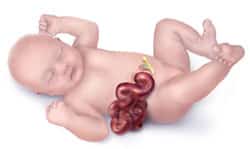
Conducted by Russell Kirby, a professor at the University of South Florida, the study examined the gastrochisis rates in millions of live births from 15 states over an 11-year period. Overall, 4,713 babies out of the 13.2 million born between 1995 and 2005 were born with the condition; this translates to about 3.5 out of every 10,000 babies. However, there was a steady incline over the course of the study, going from about 2.3 babies out of every 10,000 in 1995 to 4.4 out of 10,000 in 2005.
“I do believe the numbers,” James Robbins, a professor who studies birth defects at the University of Arkansas for Medical Sciences, who was not involved in the study told Fox News.
It should be noted, however, that the condition isn’t on the rise for all mothers. In fact, women who gave birth in their 30’s didn’t have a change in their risk factors over the study period, whatsoever. And the gastroschisis rates among Asian and Native American mothers remained steady. However, younger mothers had, in some cases, had almost double the risk when comparing rates from when the study started to when the study ended.
Among mothers in their early twenties, babies born with gastroschisis went from 4 out of every 10,000 babies in 1995 to 7 in 10,000 in 2005. But the biggest increase was seen among teen moms (those under the age of 20). For this group, the birth rate went from about every 8 babies out of 10,000 to 15 out of every 10,000.
“We have a pattern where the prevalence is very much highest among young women and it’s growing more rapidly among that group than any other group,” Kirby, who was the lead author on the study told Fox News.
Interestingly enough, researchers could see the increase happening steadily each year. For example, mothers between 20 and 25 experienced a 5.8 increase each year in their risk. Teen moms saw an increase of 6.8 percent every year. And white, black and Hispanic mothers experienced about a 4 to 6 percent increase, overall, per year.
Researchers aren’t really certain why the increase is happening. In fact, the lack of medical research on the condition means that researchers aren’t even sure what exactly causes the condition. There are some speculations, however.
For example, previous data in Washington State found that exposure to the weed killer, atrazine, was tied to an increase of having a baby born with gastroschisis. However, the study did not prove a cause and effect, so the chemical may not have actually been the reason for the malformation.
Robbins says that smoking is also considered a risk factor. However, he doesn’t believe that smoking could account for the steady increase.
“I don’t think there’s a clear explanation for why the rates are going up,” Robbins said.
Kirby says, however, that it could be possible that nutrition has played a role in the increase. And that could even tie into the higher prevalence of the condition among teen moms, since teen moms are at higher risk for poor nutrition during pregnancy. Still, even with a speculation as reasonable as this, researchers can only speculate.
“We know that there are influences of different vitamins and nutrients that definitely affect fetal development, [but] that’s just a suspicion,” Kirby said.
Related Articles:
- Smart Diapers? Do You Need To Analyze Your Baby’s Pee?
- Unborn Baby with Downs Syndrome Finds Adoptive Family Hours Before Mother Planned to Abort
- Labor Induction May Not Increase Likelihood of C-Section as Previous Research Suggests






